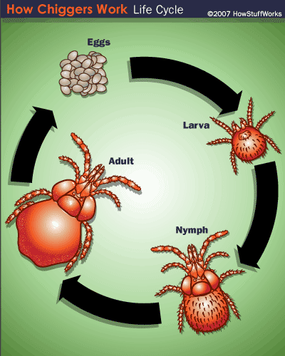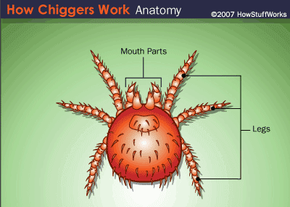Chigger Basics
Many people think of chiggers as blood-sucking insects, like fleas, ticks or mosquitoes. There are two problems with this belief. The first is that chiggers are not insects, and the second is that they don't eat blood. Chiggers are the larvae of harvest mites, and they consume the cells of their host's skin.
Harvest mites are arachnids -- they're related to ticks and spiders. Adults are small and red, and they have eight legs. They live in the soil, so people often find them while digging in yards or gardens. Adult harvest mites eat other insects and their eggs. They can be beneficial to human beings, since they often eat the eggs of other pests, such as mosquitoes.
Advertisement
Harvest mite larvae are another story. Like their adult forms, larvae are red, but they have six legs instead of eight. They are parasites that have to eat the tissues of living animals to survive. They're usually too small for a person to see, although you may be able to see groups of them on your skin.

The larvae hatch from spherical eggs that adult females lay on the ground. Harvest mites tend to lay all their eggs in one spot, which is one reason why infestations can be extremely localized. One patch of weeds might be full of newly hatched chiggers while a nearby patch has none.
After having one complete meal, harvest mite larvae drop to the ground and molt into nymphs. Like adults, these nymphs aren't parasites. Instead, they eat insect eggs. The nymphs mature into adults, and the cycle begins again with a new set of eggs.
There are thousands of species of harvest mites living all over the world, with different species native to different regions. Some of the species that tend to be a nuisance to humans include Trombicula alfreddugesi, Neotrombicula autumnalis and Leptotrombidium deliense. Leptotrombidium deliense is common in parts of Asia, and it can carry scrub typhus, a bacterial disease that's fatal if untreated, but which can be cured with antibiotics. Chiggers in other parts of the world are not known to transmit diseases to humans.
Regardless of their species, most chiggers use the same method to acquire food. Next, we'll look at how chiggers find their victims. Then, we'll explore how they eat.
